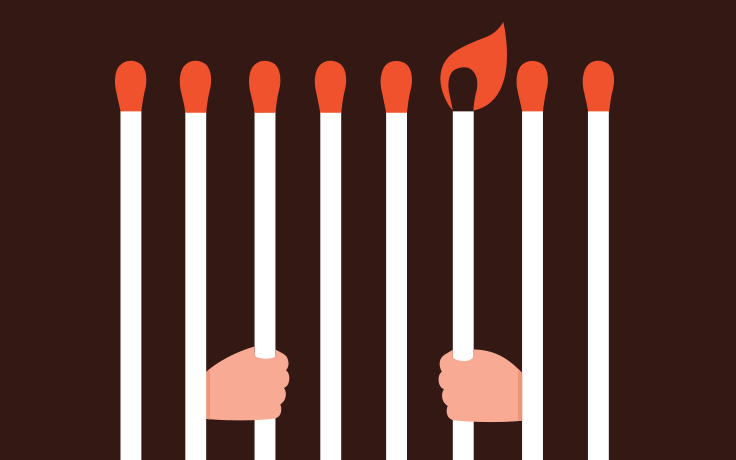More than 2 million Americans are being held captive. The majority, some 1.3 million, are in state prisons, with another 200,000 in federal lockups or immigration detention. Still another 600,000 are being held in city and county jails, with most of these individuals not convicted of any crime. On any given day, more Americans live behind bars than reside in the entire state of New Mexico.
Those numbers represent a shocking indictment of American society. Layer onto that a pandemic of a virus that spreads most readily among people who are in close contact, where ventilation is poor and access to hygiene is limited, and the elements are in place for tragedy.
It is into that breach that Sharon Dolovich, UCLA School of Law professor and faculty director of the UCLA Prison Law & Policy Program, and her colleagues leaped as COVID-19 began to carve its deadly course through American society in 2020. As the end of the pandemic now seems tantalizingly close, their work stands as a landmark of conscientious analysis and public policy.
In spring 2020, as COVID-19 was beginning to quietly show up in prisons, the Federal Bureau of Prisons issued guidelines that severely limited visitors, effectively cutting off most inmates from loved ones, while state and county facilities issued their own guidelines. Prison reform advocates, including Dolovich, realized that something serious was unfolding. “I should be on top of this,” she remembered saying to herself.
As updates poured in, Keegan Hawkins ’18, a research assistant, created an open-source spreadsheet to which advocates across the country could add information, including legal filings and updates on visitation rules. Those responses led to new information: Participants reported that judicial advocates were pushing prisons to release people to protect their health and the health of other people in confinement, so the spreadsheet expanded to track that information. Some participants raised questions about juvenile facilities, so those were added. Some states created dashboards with different types of information about COVID-19 cases and precautions; that information soon found a home in the UCLA project as well.
Deadly Institutions
The growing list was helpful, but its contents were limited to sporadic input from its voluntary contributors. Dolovich and her colleagues recognized both the potential and the limitations of the list, so they moved to expand the database and make it more comprehensive. Aided by grants, Dolovich hired data scientists to cull data from prison websites and other sources. Today, the project employs nine people, along with students and a raft of volunteers. The color-coded organizational chart now spreads across two pages.
By the fall of 2020, the spreadsheet had become a comprehensive database of COVID-19 in American prisons and an invaluable tool for those seeking information about the dangers the disease poses to the millions of people behind bars.
On a recent Saturday morning, the UCLA Law COVID-19 Behind Bars Data Project included 2,178 numbered entries (with another 26 awaiting categorization). Each entry included the name, county, state and, in most cases, a URL for a facility that held an individual in custody. The spreadsheet provided information on each of the thousands of facilities: the number of confirmed COVID-19 cases among both those incarcerated and staff; the number of confirmed deaths; the number of tests administered; the number of individuals in quarantine; and, as optimism about the possible end of the pandemic begins to creep through the nation, the number of vaccines administered.
Trouble spots jumped off the page. In the column giving the number of deaths, institutions where fatality numbers were in the double digits stood out: New York City jails, 35 deaths; Sterling Correctional Facility in Colorado, 10; St. Clair Correctional Facility in Alabama, 16; the state of Texas, 187 (facility-by-facility data for Texas are also provided); the Kentucky State Reformatory, 30; the Richard J. Donovan Correctional Facility in California, 18; San Quentin State Prison, 28. And on. And on.
The data prompted at least as many questions as it answered. Why, for instance, do so many people die in one facility, while relatively few of those infected in another location succumb to the virus? How much transmission is there between prisons and jails and the surrounding communities? Which institutions have responded most effectively, and which are overwhelmed?
But if data alone cannot answer those questions, they can at least direct attention to those states, counties and facilities that need attention. Thanks to the list, anyone with a loved one behind bars can know within minutes what the threat looks like in a particular facility.
“We’re the only place that has facility-level data,” Dolovich said. And if you are a person in prison, a guard or a family member of either, then a specific facility will draw your attention. The data are not only comprehensive but indispensable.
From Theoretical to Empirical
Dolovich comes from a family of academics. When a paper she co-authored, “COVID-19 Cases and Deaths in Federal and State Prisons,” was published in the Journal of the American Medical Association (JAMA), that left her architect sister as the only member of the family not in JAMA’s ranks. “She’s the black sheep,” Dolovich noted.
A native of Hamilton, Canada, and a graduate of Queen’s University in Canada, Harvard Law School and the University of Cambridge, Dolovich has been at UCLA Law since 2000. She has long focused on issues related to incarceration. So much of the teaching of criminal law, she notes, focuses on the portion of the system that leads up to trial and conviction: arrests, detention, criminal procedure and issues related to trials. Relatively little attention has been given to what one might call the back end of that system: the period of incarceration that follows conviction for many crimes.
“The study of the criminal justice system typically ends with the verdict,” she said. “For the rest of us, maybe. But not for the defendant.”
Early in Dolovich’s career, her work was grounded largely in theory and philosophy. She has written probingly about political and moral philosopher John Rawls and on society’s role in considering crime and punishment. And her inquiries into theories of punishment led her ever deeper into the realities of prisons. “The more I learned about prison,” she said, “the more I wanted to teach it.”
From an early grounding in theory, Dolovich moved steadily to empiricism. Today, she said, “everything I write is grounded in what actually happens in prison.”
And what has happened over the past year has been a cascading tragedy. The essential aspects of COVID-19 are cruelly suited to the prison environment. This is, after all, a disease that is passed mostly through the air, that is especially infectious in close quarters with restricted ventilation and that preys on people with underlying medical conditions such as obesity, diabetes and chronic lung disease. Enter prison, where the windows can’t be opened, people in detention cannot easily be separated, basic sanitation is often lacking and guards are not always sympathetic to complaints of illness. Prison was, predictably, a vector of infection.
A Part of — Not Apart From — Society
As Dolovich and her colleagues reported in the July 8, 2020, edition of JAMA, “The COVID-19 case rate for prisoners was 5.5 times higher than the U.S. population case rate of 587 per 100,000.” Deaths inside prison similarly outpaced those for the general population. Correcting for age — about 3% of prisoners are 65 or older, compared to about 16% of Americans overall in that age group — people in prison or jail were 3 times more likely to die from COVID-19 than their counterparts outside the system.
There is, sadly, societal indifference over those disparities. Some people aren’t bothered that prisoners are at risk and dying. Dolovich is used to that, and she has two responses.
First, she notes, prisoners are people whom society, as expressed through the criminal justice system, has determined should be confined for their wrongdoing. But they have not been sentenced to suffer from illness, much less to die. They are legally and morally entitled to safe confinement — the Constitution prohibits “cruel and unusual punishments.” None were sentenced to contract a fatal disease that might kill them because the prison was too crowded, too dirty or too ill-equipped to respond to a virus.
Second, for those too hardhearted to appreciate the moral dimensions of allowing people who are imprisoned to suffer and die, there is a practical reply: Prisons may seem formidable and removed, but people come and go all the time. Guards work shifts alongside people being confined, visitors arrive and leave, and suppliers bring food and materials. And, of course, new people come into jail or prison as others leave. “It’s not like these are closed boxes,” Dolovich said. “In jails alone, between 10 million and 12 million people cycle in and out every year.”
Our nation’s prisons have faced the ire of other health and safety professionals: California’s San Quentin State Prison, built in 1852 and today filled to 130% capacity, faced a record fine of more than $421,000 in February 2021 after 28 inmates and an officer died. But that, defenders say, takes away money that could have helped the facility prepare for the next epidemic.
Throughout the COVID-19 pandemic, Dolovich has written op-eds calling attention to the spread of the virus in prisons and arguing for decarceration. She and her students and volunteers have pressed the issue in media and academia. She is fundraising to keep the work going and expanding — donations, including grants, allow the project to continue — and they are reminding all those who will listen that people in jail are not sent there to die, and most are not sent there forever. They are part of society, not banished from it. Our disease is their disease. Because they are us.
Visit UCLA Law’s Prison Law & Policy Program to make a contribution or to contact Dolovich.

























